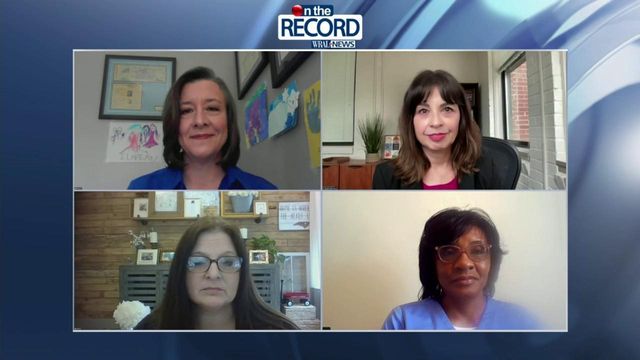NC's child care crunch threatens workforce, getting big business' attention
An often-unseen hole in North Carolina’s infrastructure is making life harder for working parents and holding back the economy: A child care shortage.
Lauren Hayworth sees it every day at the day care centers she oversees in Forsyth and Davie counties, where she tries to thread a needle: If she doesn’t pay staff enough, they’ll leave for higher-paying jobs. But pay bumps mean raising rates. And if she raises rates, she risks losing clients who find it makes more sense financially to stay at home with their kids.
Because of thin margins, day cares don't have much wage flexibility. Average day care salaries in North Carolina run about $12 an hour, according to state regulators. That’s less than many fast food restaurants pay.
“We have lost some really wonderful people with great hearts,” said Hayworth, chief operating officer at A Child’s World Learning Centers. “We’ve lost them to do things like empty the trash on a manufacturing floor because everyone is short staffed.”
Iris McRae sees it in Richmond County, where she’s struggling to keep the night shift going on her 24-hour day care. Single mothers bring their toddlers to Over the Rainbow Child Development Center to sleep while mom works the late shift.
"I have staff coming in saying, ‘Ms. McRae, I can go to McDonalds or Kentucky Fried Chicken,’” McRae said during an interview on this weekend’s episode of WRAL’s “On the Record.” "I've had 15 parents in two months have to terminate their day care services because they couldn't afford to pay out of pocket.”
The high labor demands in a long-overlooked field have stretched thin pocket books, nerves and government subsidies. And, at the end of the year, a billion-dollar federal pandemic subsidy — which has propped things up by boosting salaries and bonuses — will run out.
“It absolutely constitutes a cliff,” said Susan Gale Perry, a chief deputy secretary at the North Carolina Department of Health and Human Services.
The business community has noticed. Addressing shortages in the child care workforce is a top priority for the NC Chamber during this state legislative session, largely because the problem exacerbates workforce shortages.
Without child care, many people can’t work.
“We know we have to re-imagine how we deliver accessible and affordable child care,” said Gary Salamido, chief executive of the NC Chamber, a state business advocacy group.
Gov. Roy Cooper’s administration has told state lawmakers it will take an extra $300 million over the next two fiscal years to maintain subsidies as the federal money runs out.
What comes next remains to be seen. Businesses that used to request discounts for their employees are now offering to pay for child care themselves to secure slots and avoid waiting lists that often run more than a year, day care owners said.
Some combination of boosted state or federal subsidies, and softened regulation, could be in the offing. Some businesses may treat child care more like health insurance: Part of the cost of filling jobs.
“Probably a little bit of everything,” Salamido said. “The only solution here is going to have to be a balanced one.”
Lobbying is ongoing in Congress, and at the North Carolina General Assembly, where key lawmakers acknowledge the problem.
“Anything that we can do that facilitates the ability of North Carolinians to get and keep jobs should be and will be a priority,” Senate Republican Leader Phil Berger said. “Child care is known to be a pressing issue for a significant number of our citizens. What we, as a practical matter, can or will be able to do about that is something that … we just have to have conversations about it.”
The General Assembly’s Republican majority has repeatedly cut personal income and business taxes in recent years, changes that lawmakers credit for the state’s run of economic success. The state’s corporate income tax rate now is 2.5% with plans to hit zero in 2030.
Asked whether lawmakers might slow business tax cuts to fund child care costs, Berger, R-Rockingham, chuckled. “I’m not in favor of any increase in tax,” he said.
The Chamber says that should be on the table.
"The North Carolina Chamber just wants competitive tax rates,” Salamido said. “We've never said, ‘Go to zero.’ We think we're competitive right now. ... So, yeah, let's have that discussion."
How it works
North Carolina has nearly 5,500 day cares and pre-schools, serving 218,000 children with nearly 40,000 staffers.
For about 65,000 of those children, the state helps subsidize tuition. As of last month, the waiting list for that help had more than 5,300 names on it.
How much to whittle down that waiting list is an annual conversation in Raleigh, This is a system that day care owners and policy experts say was troubled before the Covid-19 pandemic. After the pandemic hit, some teachers left the field. The ones who stayed often teeter on the edge of burnout, day care owners told WRAL News.
Waiting lists, not just for subsidies but for cribs and seats in classrooms, increased because day cares couldn’t keep staff.
“I have no less than at least five to six pages worth of names,” said Alicia Fink, of Oak Village Academy in Wake County, said. “It’s at least a year or two for some ages.”
Fink said that, before the pandemic, she’d post an ad to hire a teacher and get 25 to 40 résumés, mostly from people with experience. Now she’s quadrupled her advertising budget, keeps at least one ad running constantly, and gets “maybe 10 résumés if I’m lucky,” she said, the majority with no experience.
Providers recruit employees away from each other. Some teachers leave to become private nannies.
“It’s a fight,” Fink said. “It’s a dog fight right now.”
The impact
A national study from Ready Nation, a booster group pushing for larger federal subsidies, pegged the economic losses from the country’s underpowered child care industry at $122 billion a year, up from $57 billion in a 2018 study.
The group said this month that $3.5 billion of that impact came in North Carolina. It also said that, of the 806 parents it surveyed with children between 0-3:
- 23% said they’d been fired because of child care problems.
- 26% said they’d quit a job over child care.
- 37% said they had their pay or hours reduced because of child care.
- 41% said they turned down a job offer due to child care concerns.
Nearly 75% reported some sort of challenge accessing child care, according to the survey.
Labor is the biggest cost driver, and the state has strict teacher-to-child ratios that vary by age and that policy makers are loath to tinker with. Day care owners don’t necessarily want to change them either.
They’re needed to keep children safe, Hayworth said. “There’s not a lot of flexibility,” she said.
But the industry would like to see education requirements revisited, and a 200-page rule book reviewed, said Sherry Melton, a consultant for the North Carolina Licensed Child Care Association. It also makes sense to look at teacher-to-child ratios in other states and compare how often problems occur with higher ratios, Melton said.
Melton said the state’s assessment program, which grades day cares and pre-schools on a five-star scale, puts too much emphasis on how much education the teachers have. Attending community college is expensive on a teacher’s salary, and it accounts for half the star rating, Melton said.
“It’s that 50% of that rating that’s killing us,” she said.
Day care owners also want to change the way subsidies are calculated. The state doesn’t cover the full cost of care, but about 75% of the average cost of day care in a given community.
McRae said this hurts rural providers, and that she buys food and materials from the same place day cares do in big cities.
“They’re not giving us any discounts,” McRae said. “So why not let [the state] pay us as much money? … The state doesn’t cut any corners with us.”
Virginia is running a pilot program now to pay actual costs instead of a portion of the market rate. Perry, the DHHS deputy secretary, said North Carolina is looking at its own alternative market rate approach and that a study will come out with recommendations within the next year.
Innovations
Yadkinville is in a child care desert: A place where there are three or more children under 5 for every child care spot available.
Local leaders see a potential answer in a program out of Minnesota. They’re raising money to build a building that would house six small childcare providers. Those providers would share, for example, a state-required playground, rotating children through it.
Sandi Scannelli, chief executive of the Shallow Ford Foundation, is working on the project and said organizers hope to break ground this spring. She sees this like a business incubator and organizers are raising money to build it.
Perry said DHHS supports innovation and will monitor the group’s progress.
But there are concerns about whether enough parents can get their children to the same place, and labor remains the No. 1 driver of costs.
Asked whether anything but money can solve the state’s child care shortages, Perry was realistic.
“I want to be creative and say yes,” she said. “But I think the bottom line is that the cost to produce child care is simply more than what families alone can afford to pay. … Fundamentally what we have is an ongoing, prepandemic, and only exacerbated by the pandemic, financing problem.”













